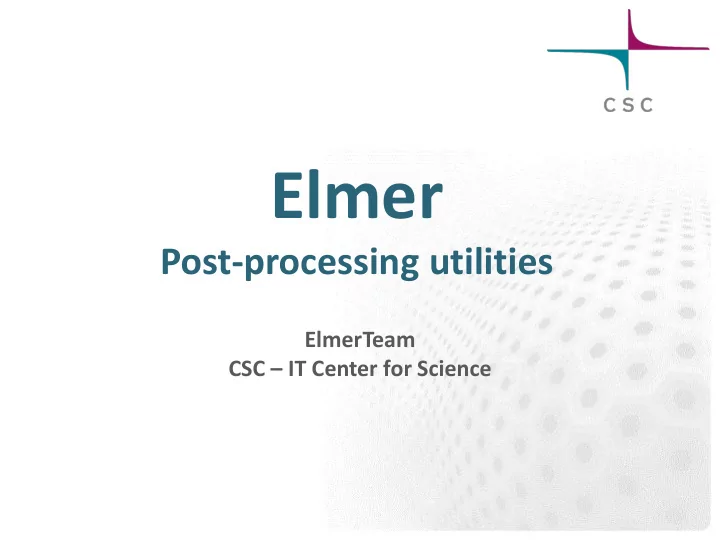

Elmer Post-processing utilities ElmerTeam CSC – IT Center for Science
Visualization capabilities of Elmer suite ElmerPost is basically ok but has some limitations – Somewhat outdated look and feel – Output resolution same as window resolution – Only one view at a time – No parallel functionality – Limited feature list compared to Paraview – Currently building challenges VTK-widget in ElmerGUI – Minimalistic visualization mimicing ElmerPost functioality Visualization tools beyond Elmer suite as mainly used – Paraview!
Visualization tools – Poll (3/2014)
Exporting 2D/3D data: ResultOutputSolve Apart from saving the results in .ep format it is possible to use other postprocessing tools ResultOutputSolve offers several formats – vtk: Visualization tookit legacy format – vtu: Visualization tookit XML format – Gid: GiD software from CIMNE: http://gid.cimne.upc.es – Gmsh: Gmsh software: http://www.geuz.org/gmsh – Dx: OpenDx software Vtu is the recommended format! – offers parallel data handling capabilities – Has binary and single precision formats for saving disk space – Suffix .vtu in Post File does this automatically
Exporting 2D/3D data: ResultOutputSolve An example shows how to save data in unstructured XML VTK (.vtu) files to directory ” results ” in single precision binary format. Solver n Exec Solver = after timestep Equation = "result output" Procedure = "ResultOutputSolve" "ResultOutputSolver" Output File Name = "case" Output Format = String ” vtu ” Binary Output = True Single Precision = True End Basic functionality also just by adding suffix .vtu to the Post File in simulation section
Case: View in Paraview
Example: view in GiD
Example: view in Gmsh
Visualization with Paraview
Exporting 2D/3D data: ResultOutputSolve By setting suffix for Post File to .vtu paraview format is saved automatically. An example shows how to save data in unstructured XML VTK (.vtu) files to directory ” results ” in single precision binary format. Solver n Exec Solver = after timestep Equation = "result output" Procedure = "ResultOutputSolve “ " ResultOutputSolver" Output File Name = "case" Output Format = String ” vtu ” Binary Output = True Single Precision = True Save Geometry Ids = True End
Filename conventions Suffix of unstructured XML based VTU file is .vtu Timesteps numbered #step Partitions numbered with #part par #step Holder for vtu files in parallel is .pvtu
Loading data Note: Paraview may have several datasets at the same time!
Solid color
Moving object in Paraview Rotate – Mouse: Left bottom Scale – Mouse: Right bottom Translate – Mo u se: Center bottom
Setting background color
Color mesh with surface + edges
Paraview uses extensively filters to create new datasets Filters and datasets may be set active or passive by clicking the eye Several datasets may be visualized at the same time
Plotting a slice
Plotting a clip
Vector plot
Vector plot + opaque solid surface
Vector plot + solid surface with Id treshold
Change of colormap
Deformation – WarpByVector filter
Plot line – PlotOverLine filter
Streamlines – Filter StreamTracer
Partitioning – Connectivity filter
File size in Paraview output Memory consumption of vtu-files (for Paraview) was studied in the ” swiss cheese ” case Saving just boundaries in single precision binary format may save over 90% in files size compared to full data in ascii With larger problem sizes the benefits are amplified Binary Single Only Bytes/ output Prec. bound. node - X - 376.0 X - - 236.5 X X - 184.5 X - X 67.2 X X X 38.5 Simulation Peter Råback, CSC, 2012.
Saving figures
Saving animations with Paraview The only packing method that comes with Paraview by default is motion AVI It is advicable to save the animation as separate files You may use ElmerClips to make mpg animations of the separate png figures
Visualization with ElmerPost
How to write files for ElmerPost Default suffix is .ep May be requested in Simulation section Post File = case.ep Or using ResultOutputSolver with Output format = ElmerPost
Loading data Assume data in case.ep File -> Open -> case.ep Here the timesteps are chosen If element edges or sides are not defined for BCs they may have to be created here
Solid color
Moving object in ElmerPost Rotate – Mouse: Right bottom – Click: – Command line, e.g.: rotate 30 45 60 Scale – Mouse: Both bottoms – Click: – Command line: scale 1 10 1 Translate – Mouse: Left bottom – Click: – Command line: translate 1 2 3
Setting background color Click: – Edit -> Background – Set 100.0 100.0 100.0 for white Command line – background 100 100 100
Color mesh with surface + edges
Plotting isosurfaces
Using clip planes
Isosurface + surface plot + clip planes
Vector plots
Vector plot + solid surface
Surface plot + Isosurfaces + Opaque
Change of colormap
Selecting active geometric entities
Saving figures File -> Save Image -> jpg
Deformation in geometry Assume displacement field in variable ”Displacement” Set in command windows: math n0=nodes math nodes=n0+Displacement Replot
Conclusions Use Paraview and VTU format For large visualizations ViSiT could be an option
Recommend
More recommend